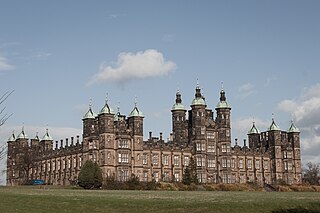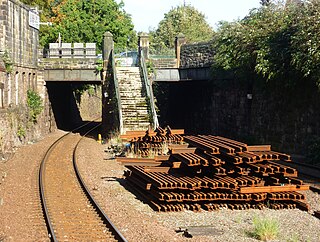
Lanarkshire, also called the County of Lanark, is a historic county, lieutenancy area and registration county in the central Lowlands of Scotland.

Carnwath is a moorland village on the southern edge of the Pentland Hills of South Lanarkshire, Scotland. The village lies about 30 mi (50 km) south of both Edinburgh and Glasgow. It is bounded by the North Medwyn and South Medwyn watercourses.

The Calders is a residential neighbourhood in Edinburgh, Scotland – not to be confused with the Calders of West Lothian aka West Calder, Mid Calder and East Calder, three separate villages. It is sometimes considered to be part of Wester Hailes or Sighthill, larger developments to its south and east respectively. From 2007 to 2017, it fell within the Sighthill/Gorgie multi-member ward of the City of Edinburgh Council administration along with Sighthill, but following a boundary change has been in the Pentland Hills ward since then, along with Wester Hailes.

Curriehill is a suburb of Edinburgh, the capital of Scotland. It is north-west of Currie.

West Coates or Wester Coates is a residential district of central Edinburgh, the capital of Scotland. It is on the A8, in proximity to Haymarket railway station and Roseburn, west of the city centre, bounded by the Water of Leith on its north side.

Dunsyre is a village in South Lanarkshire, Scotland. It is 10 kilometres (6 mi) from Carnwath. Dunsyre is associated with an ancient barony and parish church. The name of Dunsyre is of Celtic origin and is supposed to signify the "Hill of the Seer." It is located by the burn known as the South Medwin Water.

Brimscombe Bridge Halt was opened on 1 February 1904 on what is now the Golden Valley Line between Kemble and Stroud. This line was opened in 1845 as the Cheltenham and Great Western Union Railway from Swindon to Gloucester and this was one of many small stations and halts built on this line for the local passenger service. This halt opened following the introduction of the GWR steam railmotor services between Stonehouse and Chalford. The halt was between Brimscombe and Stroud, and featured staggered platforms either side of the overbridge for the local road "Brimscombe Hill", with the down platform on the East side and the up platform on the West. Access to the basic wooden platforms was from the overbridge. Each with GWR pagoda style shelters soon after opening and electric lighting was installed in February 1939 at an estimated cost of £90.

Scotland Street Station was a railway station which stood in a cutting at the north end of Scotland Street, in Edinburgh, Scotland. First opened as Canonmills by the Edinburgh, Leith and Newhaven Railway, Scotland Street stood at the southern end of Scotland Street Tunnel that linked the city centre under the New Town to Canal Street. The trains that used the station were rope hauled by stationary steam engine.

Newington Railway Station was a railway station in Edinburgh, Scotland, on the Edinburgh Suburban and Southside Junction Railway. It served the southern Edinburgh suburb of Newington and the station site is still visible from Craigmillar Park.
The Holywell branch line was a railway branch line in North Wales that connected Holywell with the nearby main line railway. Holywell had plentiful mineral resources, and the branch line was built as a mineral railway. When the local industry declined, the line fell into disuse, but it was reopened as a tourist passenger line in 1912. Road competition made heavy inroads into that business, and the line closed in 1954.
Poyle Estate Halt railway station was opened by the Western Region of British Railways on 4 January 1954 between Colnbrook and Poyle Halt on the Staines West Line. It closed to passengers on 29 March 1965. No relic of it remains.
Dolphinton is a village and parish in Lanarkshire, Scotland. It is located 7 miles (11 km) northeast of Biggar, 11 miles (18 km) northeast of Carstairs, 10 miles (16 km) southwest of Leadburn and 27 miles (43 km) southwest of Edinburgh, on the A702 road.

Longriggend is a village in North Lanarkshire, Scotland, with a population of approximately 200. It is situated on moorland 8 km north-east of Airdrie, in the parish of New Monkland. It is roughly half way between Upperton and Caldercruix. The village appeared on a map by Timothy Pont, under the name of Langrodge. It was published in 1596 but the letters are difficult to read. The toponymy is listed along with other -rigg placenames. Longriggend is also shown on another map by Roy c1754. Slamannan Railway joined Longriggend with Airdrie and the Union Canal in 1840, but its gauge prevented its connection with the Edinburgh & Glasgow Railway. Coal pits in the area used the railway extensively, and by 1895 there was a station at Longriggend. By 1901 its population had reached over 1500, and it had a post and telegraph office, and an inn nearby.
The Dolphinton Branch refers to two railway branch lines in Lanarkshire and Peeblesshire, Scotland, built in the nineteenth century.
Lennoxtown railway station served the town of Lennoxtown, Dunbartonshire, Scotland from 1848 to 1881 on the Blane Valley Railway.
Bankhead railway station served the isolated settlement of Bankhead, east of Carstairs Junction in South Lanarkshire, Scotland from 1867 to 1945 on the Dolphinton branch.
Morningside railway station served the village of Morningside, North Lanarkshire, Scotland from 1844 to 1930 on the Wishaw and Coltness Railway.
Newmains railway station served the village of Newmains, North Lanarkshire, Scotland from 1867 to 1930 on the Cleland to Morningside Line.

The Denburn Valley Line was a connecting line constructed to connect the northern end of the Aberdeen Railway and Deeside Railway to the southern end of the Great North of Scotland Railway mainline.
Smeaton railway station served the village of Smeaton, south of Musselburgh in East Lothian, Scotland, from 1872 to 1930 on the Macmerry Branch.











